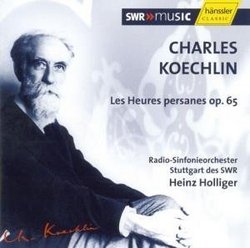Persian Dreams
D. A Wend | Buffalo Grove, IL USA | 05/07/2010
(5 out of 5 stars)
"Charles Koechlin wrote Les heures persanes as a piano suite that he completed in 1919. He orchestrated the music in just two weeks in 1921. The entire suite was not performed during the composer's lifetime receiving its first performance in 1986. Charles Koechlin never traveled to Persia (modern Iran) but based his impressions on a book by Pierre Loti written about his expedition in 1906. There also is an element of The Thousand Nights and a Night stories in the Story-Teller section.
The music is strongly impressionistic filled with exotic colors. The music follows a time pattern of two and a half days as a caravan travels. Time in the suite is marked as night and day. The beginning number is titled Siesta, before departure and depicts the caravan traveling during the night, coming to a town in a mountain valley. Various impressions of the town are put into music: an exciting description of the streets, moonlight on the terraces, roses in the midday sun and being the shade near a marble fountain. The suite concludes with a depiction of a cemetery in the evening, dervishes at night and moonlight on a deserted square, concluding the piece as it began with dream-like music.
Koechlin creates an exotic sound-world without resorting to quoting Arabic music. If you have heard anything from the composers Jungle Book tone poems you know how remarkably Kochlin's sound world can create sensations of a being in a real place. The same is true for this music. Kochlin's harmonies and use of melody was ahead of his time; he plays with atonality and makes use of unusual keys. Like Mompou in his piano music, Koechlin can make time stand still. You might have to listen a few times to appreciate Koechlin's sound world. It is sometimes exciting but is most often introspective, concentrating on shadings and colorings like no other composer.
Heinz Holliger is an excellent advocate for Koechlin's music and has recorded several of his works. This recording is beautifully played and nicely engineered. This is the kind of CD that one can put on, lay back with your eyes closed, and see in your mind what Charles Koechlin sees in his music.
"


 Track Listings (16) - Disc #1
Track Listings (16) - Disc #1